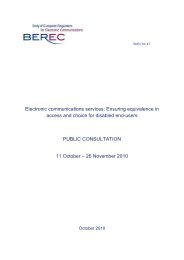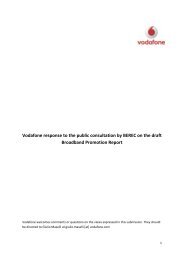BEREC REPORT ON IMPACT OF FIXED-MOBILE ... - berec - Europa
BEREC REPORT ON IMPACT OF FIXED-MOBILE ... - berec - Europa
BEREC REPORT ON IMPACT OF FIXED-MOBILE ... - berec - Europa
You also want an ePaper? Increase the reach of your titles
YUMPU automatically turns print PDFs into web optimized ePapers that Google loves.
BoR (11) 54<br />
For example, when faced with a SSNIP at the wholesale level, retail operators using<br />
those services may (depending on the relative share of this wholesale inputs in the<br />
retail price) need to pass this price increase on to end-users, which would mean a<br />
decrease in demand in favour of integrated operators and, therefore, less demand for<br />
indirect access wholesale services. This would have repercussions on the profits for<br />
the operator providing such services, possibly making an increase in wholesale prices<br />
not profitable, although this would also depend on the balance between the integrated<br />
wholesale suppliers overall wholesale/retail profits. This competitive situation is shown<br />
in the following illustration:<br />
Indirect price constraints<br />
Assumptions:<br />
1. In the wholesale market there is a single monopolistic undertaking that sells to 2 companies :(A and B) at the retail level;<br />
2. The mobile operator is a vertically integrated undertaking that has a wholesale division and a retail division<br />
that competes with A and B.<br />
3. They compete on price (Bertrand competition), therefore the result is that, in the retail market, the three companies set<br />
the same price P and demand is divided between the 3.<br />
4. The wholesale input cost represents a relevant share of the retail price.<br />
In this scenario, if the monopoly wanted to raise prices for the wholesale service, companies A and B would have to set price s<br />
at P 1 >P, thereby losing all demand and this would go to the mobile undertaking. Therefore, in this scenario, competition at<br />
the retail level restricts the monopolist’s ability to act at the wholesale level.<br />
Alternative retail<br />
undertaking A<br />
Fixed wholesale<br />
operator<br />
(monopolist)<br />
Alternative retail<br />
undertaking B<br />
Mobile operator<br />
(wholesale division)<br />
Mobile operator<br />
(retail division)<br />
(P;Q/3) (P;Q/3) (P;Q/3)<br />
Although realistically it is much more complicated than illustrated above, the model<br />
shows that, under certain circumstances, a competitive retail market could conceivably<br />
discipline the behaviour of a monopoly in the upstream market. In that case, self-supply<br />
should be taken into account for wholesale market analysis 61 . The consequences of<br />
this decision could be that the market would be broader since mobile operators would<br />
61 For a more detailed analysis of this question refer to: BoR (10) 09 <strong>BEREC</strong> report on self supply.<br />
Wholesale Market<br />
Retail Market<br />
49





